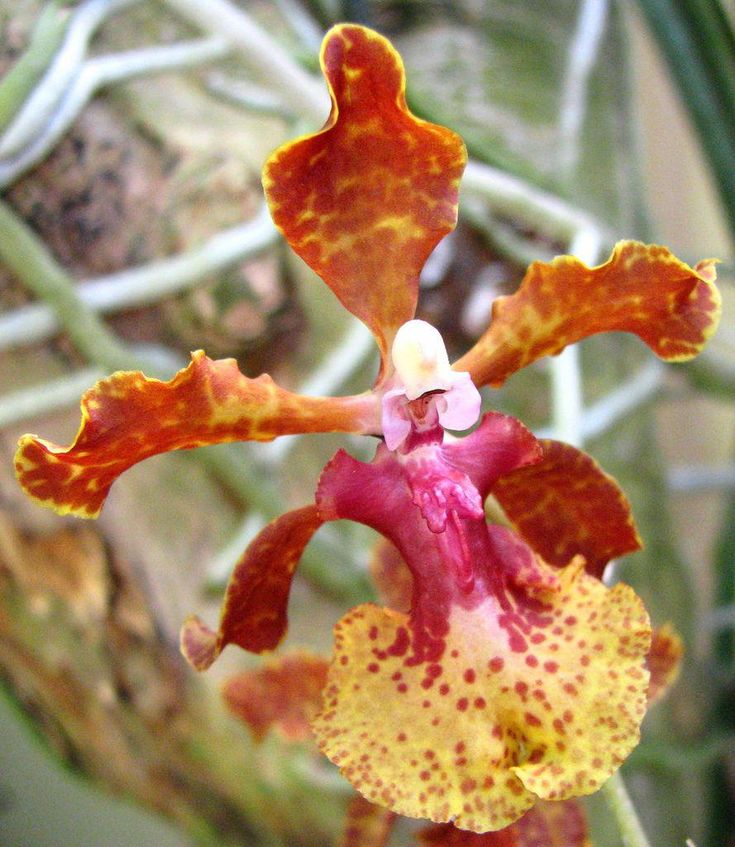How to plant dancing lady orchid
Growing Orchids: Oncidium, or Dancing Lady
Fill your home with dancing sprays of delicate blossoms when you start growing orchids in the Oncidium family.
If you’ve mastered the skill of growing orchids like phaelanopsis and dendrobiums, you might be ready to step up to more challenging varieties like ondidium orchids, fancifully known as “Dancing Ladies.” These orchids are a bit pickier about light, temperature, and watering requirements, so do your research carefully before giving them a try. Here are some basics to get you started.
About Oncidium
Oncidium (say “on-SID-ee-um”) orchids are New World orchids, found in South and Central America and the West Indies, with one species in South Florida. There are over 300 species of oncidiums, but the most popular for home growers are the yellow or pink-flowered varieties sold simply as “Dancing Lady.” These are generally large plants, with long and abundant leaves. They flower in late summer or early fall, with dozens of blooms on multiple stems that can last for months. After they finish blooming, they enter a growth cycle, where they put on new leaves. They’re dormant in the early summer as they prepare to bloom again.
Temperature
Dancing Lady orchids like warm temperatures and moderate humidity. They prefer a minimum of 80 degrees F during the day, with at least 40% humidity. At night, they can tolerate temperatures down to about 55 degrees F. In some areas, you may find it hard to maintain the required temperatures and humidity during the winter months without a greenhouse. However, if you can keep oncidiums in a warm room and provide extra humidity (setting the pot on a shallow tray filled with pebbles and water helps), growing orchids in this family may be a possibility.
Light
Oncidiums tolerate more direct light than some other orchids. They do well in east or west windows, though it doesn’t hurt to soften the light a bit with a sheer curtain. Healthy Dancing Lady orchids have medium green leaves; dark green leaves indicate they aren’t getting enough sun.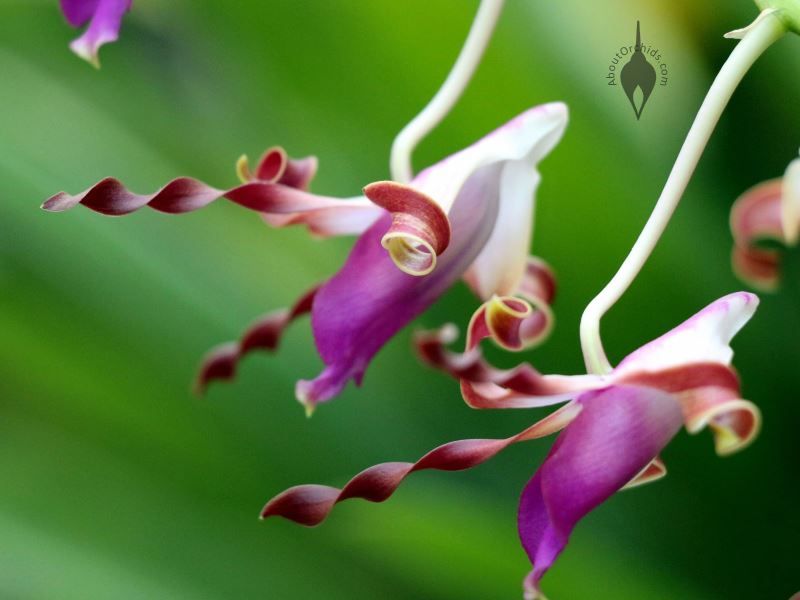
Jill Staake
Water
Watering oncidiums properly can get tricky. They are very susceptible to root rot, so like other orchids they should never be left sitting in water. In fact, it’s best to let the potting mix dry out about halfway down the pot before watering. Stick your finger or a wood popsicle stick down into the mix. If it still feels wet, wait a few days more. The time between waterings will vary depending on the time of year and the plant’s growth cycle.
Potting and Fertilizing
Orchids need quick-draining potting material. Specially-designed orchid mixes made of bark, sphagnum moss, and other loose fillers are ideal. Do not use traditional potting soil or soil from your garden. Ensure the pot has holes for good drainage. Feed with a weak fertilizer once or twice a month. It’s better to underfeed than overfeed when growing orchids.
Maintenance
When the flowers begin to fade, allow them to drop naturally. Don’t remove the flower spike until it has turned completely brown and dry. Oncidiums prefer to be somewhat pot-bound, but may need re-potting every couple of years. This requires a cautious hand so as not to break the roots. Do a web search before re-potting to find a site that can walk you through the process.
Don’t remove the flower spike until it has turned completely brown and dry. Oncidiums prefer to be somewhat pot-bound, but may need re-potting every couple of years. This requires a cautious hand so as not to break the roots. Do a web search before re-potting to find a site that can walk you through the process.
Interested in more on growing orchids? See our guide to Orchids 101 here.
Popular Videos
Jill Staake
Jill lives in Tampa, Florida, and writes about gardening, butterflies, outdoor projects and birding. When she's not gardening, you'll find her reading, traveling and happily digging her toes into the sand on the beach.
How To Care And Grow For Dancing Lady Orchid
Oncidium Orchids are popular members of the Orchidaceae family that are native regions of South and Central America including the Caribbeans.
They are epiphytic in nature and are often found growing on the bark of trees and can be used as ornamental plants for indoor spaces.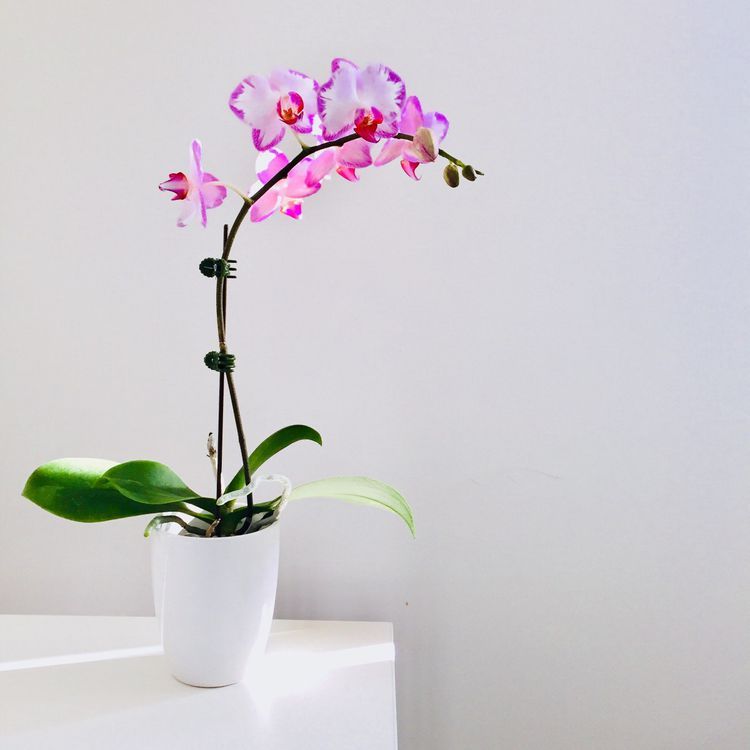
Oncidiums are known for their large pseudobulbs and long leaves which can reach a height of 2 feet. They also produce abundant pink, yellow or purple blooms that are modified and look ruffled, these ruffled flowers are the reason the plants are called “dancing lady orchids’.
| Botanical Name | Oncidium Spp |
| Common Names | Oncidium Orchid, Dancing lady orchid |
| Origin | Caribbean, South and Central America |
| Family | Orchidaceae |
| Plant Type | Epiphytic perennial flowering plant |
| Full Size | Ranges from 2 feet to 10 feet tall |
| Sun Exposure | Partial, indirect sunlight |
| Growth Media | Well-draining media |
Oncidium Orchid Types
There are tons of oncidium varieties being produced, this is because they are hybridized so it is easy to introduce new species. Some popular varieties are;
- Oncidium pulchellum
- Oncidium leucochilum
- Oncidium sarcodes
- Oncidium longipes
Caring for Oncidium Orchid
Oncidium orchids are easy to grow and care for, they are a bit more tolerant than most orchid types and would flourish under the right lighting, watering, temperature and humidity conditions.
Oncidium Light Requirements
Oncidiums are better grown in areas with sufficient access to bright and indirect sunlight, still, they are much more tolerant to direct sunlight than most orchids.
Prolonged exposure to direct sunlight does have its negative effects on the plants leaves, so it helps to filter the sun’s rays with a light curtain.
Place the potted plant in a room, close to an eastwards facing window where they can get access to the morning sunlight, you can then relocate them to a room with bright indirect sunlight during the mid day.
Oncidium orchids and Dendrobium orchids have similar lighting requirements.
Water Requirements for Oncidium Orchids
It is recommended that you water the Oncidium Orchid every 2 to 7 days, this varies depending on the species of the plant.
Avoid a wet growing media as it can open the plant to fungal and bacterial attacks, so it helps to maintain a moist media by letting it dry off a bit before watering.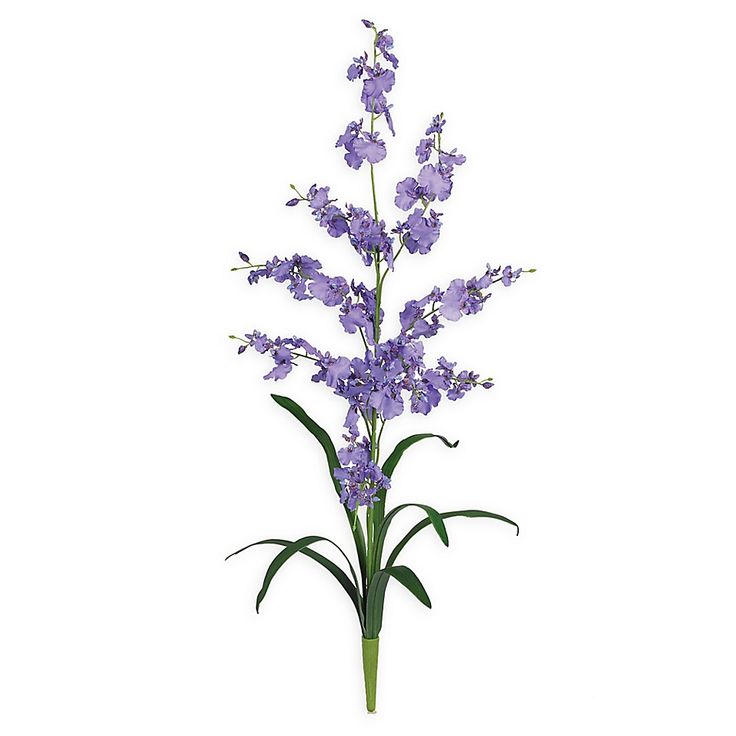
When watering, ensure you use dechlorinated water that is of lukewarm temperature to avoid stress on the plant’s roots.
Soil Requirements for Oncidium Orchids
As epiphytic plants, Oncidiums don’t require regular soil mixes, opt for a bark-based medium instead when growing them in pots.
Ensure that your mix is well-draining, a little acidic, and should be able to hold in moisture for a while. You can achieve this with the addition of peat moss and perlite.
Temperature and Humidity Requirement for Oncidium Orchids
Orchid Oncidium has a higher tolerance for most climatic conditions and can be found growing in tropical regions. The temperature range should be from 55 degrees Fahrenheit to 85 degrees Fahrenheit.
Keep the humidity level between 40% to 60% and this could be achieved indoors with the use of a humidifier or by placing the plant next to a tray filled with pebbles and water.
Fertilizer Requirements for Oncidium Orchids
This should be done once every month in its growing season by using a slow-release fertilizer or an orchid-suitable fertilizer.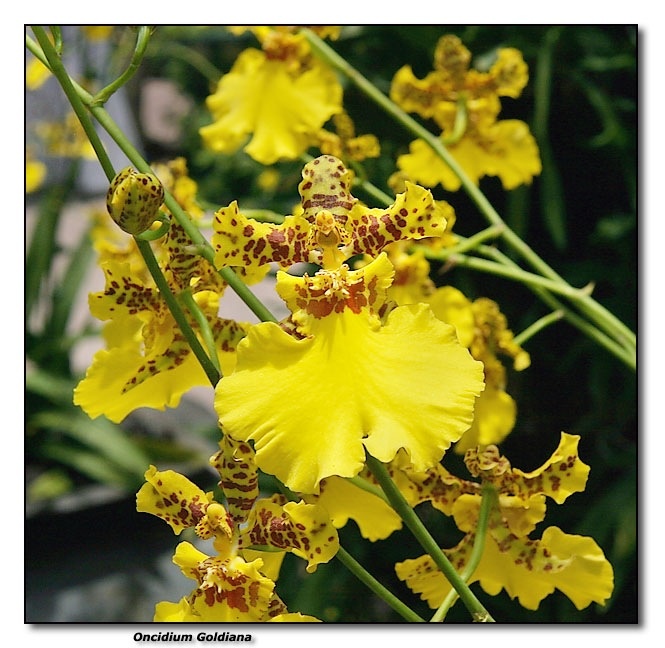
If the Oncidium Orchid species is large, it would require a 30-10-10 fertilizer, else you can use a 20-20-20 fertilizer.
Be sure to do thorough flushing of the plant with water to reduce the buildup of salts from fertilizer on the plant.
Propagating Oncidium Orchids
Oncidium Orchids can be propagated through two methods;
- Propagation by seed
- Propagation through by division
Repotting Requirements for Oncidium Orchids
Oncidium orchids do not require frequent repotting as they can grow for years without needing a new pot. Repot when it is necessary and ensure you use a bigger pot with sufficient drainage holes.
Pruning Oncidium Orchids
Pruning should be done after the Oncidium Orchid has finished flowering, to help promote the growth of new flowers.
Common Health Problems of Oncidium Orchids
- Root rot
- Scales
- Mealybugs
- Thrips
- Aphids
- Brown leaves
- Discolored leaves
- Black spots
Frequently Asked Questions
How long do Twinkle Oncidium orchid flowers last?
This species of the Oncidium genus produces blooms that last for about 4 weeks
Are Oncidium orchids easy to grow?
Yes, Oncidium orchids are fast and easy to grow and care for.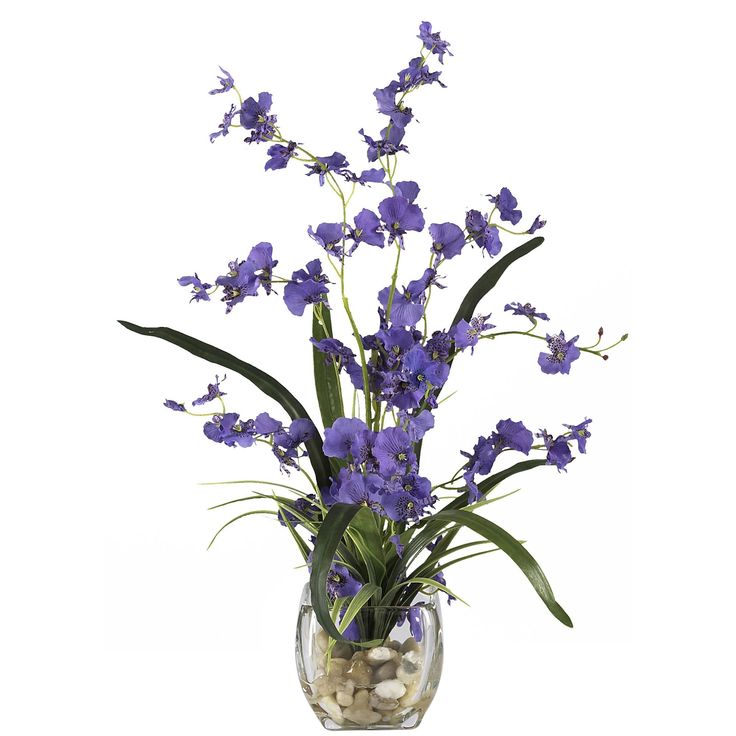
Why are my Oncidium leaves turning yellow?
A yellow-colored Oncidium leaf is normal and should not bother you.
Do orchids like to be root bound?
Frequent repotting is not necessary as Oncidiums prefer being pot-bound.
Should you water orchids while blooming?
Yes, regular watering should be done while oncidium orchids bloom.
Growing Cattleya Orchids - The proper guide to caring for the Cattleya Flower
Growing and Caring for Vanda Orchids
home care, what to do if the leaves dry, how to plant a baby, choose a substrate and a pot
Orchids are appreciated by indoor plant lovers for their bright exotic flowers. Oncidium is distinguished not by the spectacular color of the petals, but by their unusual shape. The plant is deservedly considered rather capricious when cared for at home.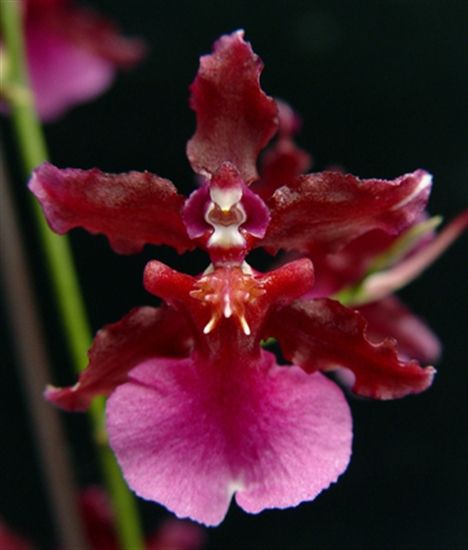 The grower is required to know certain rules and strictly follow them. Therefore, a novice orchidist should first practice on less whimsical representatives of the genus - for example, cattleyas and phalaenopsis. nineOl000
The grower is required to know certain rules and strictly follow them. Therefore, a novice orchidist should first practice on less whimsical representatives of the genus - for example, cattleyas and phalaenopsis. nineOl000
3 How to create an optimal microclimate for a flower
-
3.1 Table: optimal conditions for growing oncidium
4 Procedure for landing and transplantation
-
4.1 Preparation for transplanting to the new pot
-
4.2 Step -by -step instruction
4.3 Video: how to properly transplant orchid
5 venerable nuances for bloom
-
5.1 Watering
-
5.2 Fertilizing
-
5.3 Dormancy
-
5.4 Video: Proper Plant Care
-
5.5 Flowering
-
5.6 Video: How to force the oncidium to bloom
6 Typical errors of the novice flower grower
-
6.
 1 Table: how oncidium reacts to errors in caring
1 Table: how oncidium reacts to errors in caring
-
7.1 Table: common diseases and pests of oncidium
-
7.2 Photo gallery: what diseases and pests will you encounter when growing oncidium
8 Propagation of oncidium at home
What an orchid Oncidium looks like
Oncidium is one of the many genera in the Orchidaceae family. Most of its representatives prefer a tropical climate and low altitude (up to 3000 m above sea level).
Almost all oncidiums are epiphytes or lithophytes. They do not live on the ground, but on trees and rocks, clinging to cracks in the bark and stones with their roots. At the same time, they are not parasites - the "host" is used only as a support. The plant absorbs moisture and essential nutrients from the atmosphere, having a developed system of aerial roots. nine0003
Most of the oncidiums are epiphytes
About 750 representatives of the genus Oncidium are currently known.
Mankind has been familiar with these orchids for a long time. The first of them was described at the beginning of the 19th century by the famous Swedish botanist Peter Olof Swartz. Most oncidiums can be found in northern Brazil, in Mexico on the Caribbean islands, in the southern and southeastern states of the United States.
"Natural" plants are quite large. Leaf length reaches 35–40 cm, peduncles can stretch up to 1.5–2 m. But there are also miniature breeding hybrids no more than 15 cm high.
From the point of view of professional botanists, oncidium is a sympodial orchid. This means that its rhizome (rhizome) grows in only one direction. Each new shoot is formed from a bud located at the base of the previous one. Underground rhizomes are rather small, but aerial roots are fleshy and thick. They are covered with a thick layer of velamen (special "spongy" tissue), which is "responsible" for the absorption of moisture from the atmosphere.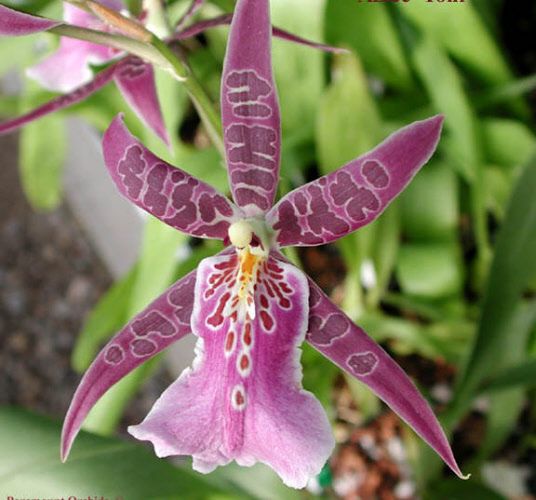 nine0003
nine0003
Tuberidium (pseudobulb), in which orchids accumulate water and nutrients “in reserve”, many oncidiums are deprived. If they are, then they resemble a spindle in shape, dry out and wrinkle over time. Each has from one to three belt-like or lanceolate leaves and several basal, more like integumentary scales.
Oncidium pseudobulbs, compared to other orchids, are small, and some species are completely devoid of them
The name of the plant was due to the specific structure of the lip. Translated from the Greek onkos - "tubercle" or "tumor", and eidos - "view", "image". The popular nickname is more poetic. The lip itself resembles a puffy skirt of a ball gown, and small petals - the hands and head of a girl. Therefore, the oncidium is known as the "dancing chrysalis" or "dancing lady". nine0003
Peduncles are formed in the axils of the lowest leaves. They branch intensively, so there are a lot of buds, although the flowers themselves are quite small.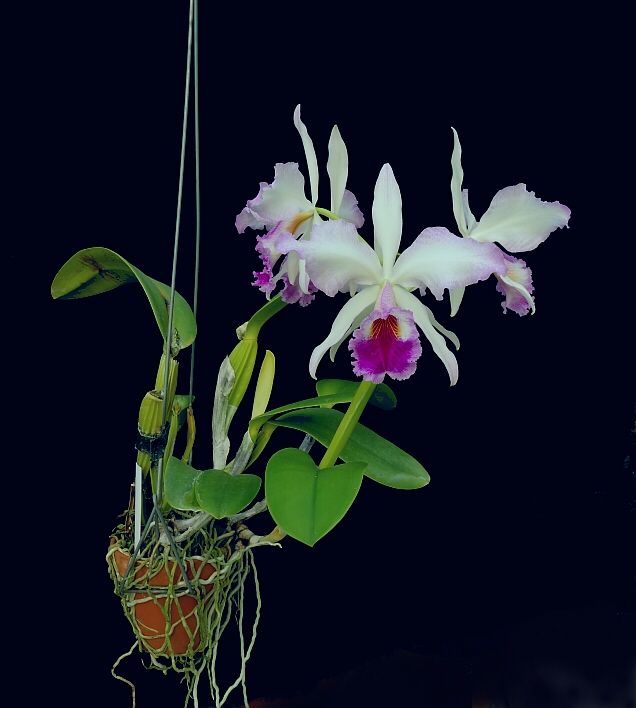 The inflorescence falls beautifully, forming a cascade.
The inflorescence falls beautifully, forming a cascade.
Oncidium compensates for the relatively small diameter of the buds with the branching of the inflorescence, similar to a golden waterfall.
Flowering can begin at any time. In favorable conditions, it is repeated twice during the year. In most species, the color of the petals is different combinations of bright yellow, brick, chocolate, but there are also cream, pinkish, lilac shades. The aroma, if present, is reminiscent of vanilla. nine0127 The diameter of the flower varies from 1 to 12 cm. The cut inflorescence does not wither for 15–20 days.
The structure of the flower is quite specific. The large lip is shaped like a guitar. On it is a fleshy outgrowth similar to a scallop, pubescent with a short “pile”. Petals small, slightly recurved. A pair of lateral sepals can fuse into one.
Oncidium got its name because of the unusually large lip
Video: what an oncidium looks like
Popular varieties grown at home
The genus Oncidium is quite numerous, but not all of its representatives have adapted to the microclimate of modern apartments. Serious "competition" for them is also breeding hybrids. The most popular among amateur flower growers are:
- Warty oncidium (varicosum). Pseudobulbs are cylindrical, each with two leaves. They are quite thin, salad shade. The inflorescences are strongly branched, they contain up to a hundred buds. Petals are bright yellow. Most often, the buds at home bloom in August and last for about two months. nine0014
- Limming's oncidium (limminghei). miniature plant. Leaves 3-5 cm long, pseudobulbs almost round, flattened. The height of the peduncle is no more than 10 cm. One bud blooms on it. The flower is 4-5 cm in diameter, the petals are pale yellow with reddish-orange spots.
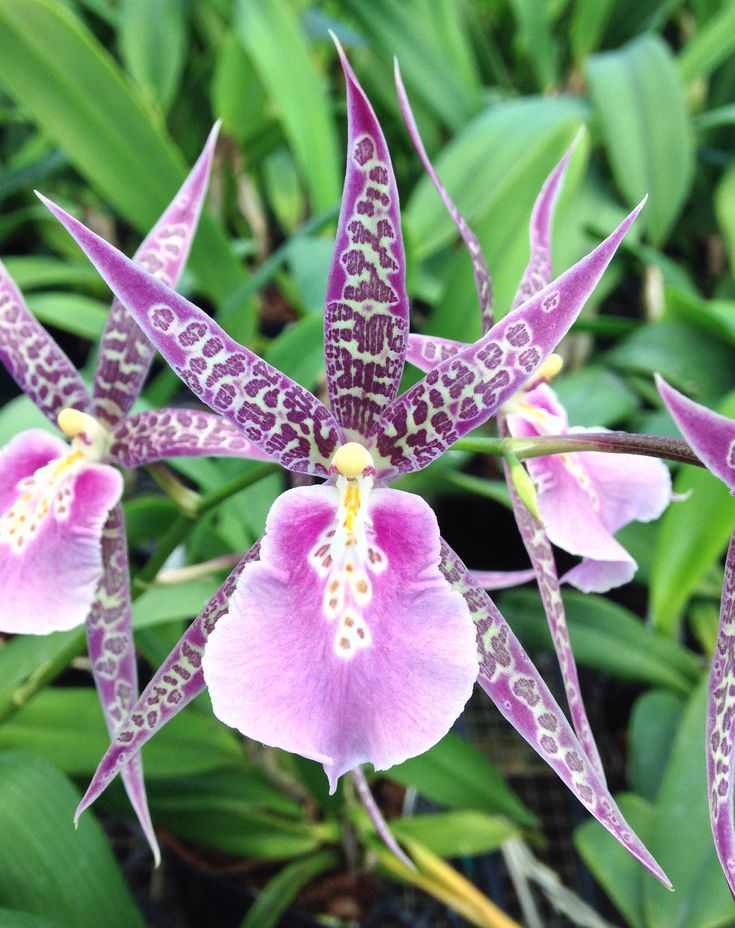 Most often, flowering occurs at the end of summer or the beginning of autumn.
Most often, flowering occurs at the end of summer or the beginning of autumn. - Butterfly oncidium (papilio), aka "butterfly orchid". Often found at home. Leaves of an olive shade with lighter "marble" divorces. It produces a peduncle up to 80 cm high, which lasts for 2-3 years. Periodically, a flower blooms on its top, similar to a butterfly with long antennae. The petals are narrow, reddish-orange, with yellow strokes and large spots. At the base, the shade changes to lime. The lateral sepals are beige, the lip is bright yellow with scarlet and brownish speckles. nine0014
- Oncidium sinuous (flexuosum). The rhizome is very long, so the pseudobulbs are located at a considerable distance from each other. Dark green leaves grow up to 35-40 cm in length. Inflorescences in the form of a brush or panicle consist of many small golden flowers with reddish specks on the petals. They bloom most often in autumn.
- Lance's oncidium (lanceanum). The pseudobulb does not form. The leaves are leathery, pale green, covered with chocolate-purple "specks".
 On the peduncle up to 20 buds. Lime-colored petals, with small brick spots. The lip at the base is inky purple, then the tone changes sharply to white. Blooms mainly in autumn. nine0014
On the peduncle up to 20 buds. Lime-colored petals, with small brick spots. The lip at the base is inky purple, then the tone changes sharply to white. Blooms mainly in autumn. nine0014 - Fine or brilliant oncidium (spendidum). Each pseudobulb has one leaf, slightly folded back. They have a very interesting green-purple hue. The height of the peduncle is up to 1.5 m. It is straight, with very few branches. There are 15–20 flowers with a diameter of 5–8 cm. The petals are bright, as if glossy. Flowering occurs at the end of autumn or the beginning of winter, lasts 2–2.5 months.
- Tiger oncidium (tigrinum). Pseudobulbs are very closely spaced, each with one leaf. The lemon-colored lip looks like a bud ready to bloom. Petals with corrugated edges, bright yellow with chocolate spots, strongly recurved. Blooms in winter. nine0014
- Curly oncidium (crispum). The inflorescence branches very intensively, resembles an arc. 25-30 buds are formed on it. The flowers are 6–8 cm in diameter.
 The petals are brownish with a bright yellow border. Lip of the same shade with a large lemon spot in the center. Blooms most often in summer.
The petals are brownish with a bright yellow border. Lip of the same shade with a large lemon spot in the center. Blooms most often in summer. - Oncidium Sweet Sugar. One of the most popular breeding hybrids. The height of the peduncle is up to 35 cm. The pseudobulbs are small, closely spaced. Each has two sheets. The diameter of the flower with bright yellow petals is 2.5–3 cm.
- Oncidium Sharry Baby. Produced artificially. The leaves are 40–45 cm long. The flowers are small, with reddish-brown petals. Very "delicious" chocolate-honey aroma.
- Oncidium Twinkle. A group of varieties that combines miniature (no more than 10 cm high) hybrids. Compared to natural orchids, it is more frost-resistant. Flowers with a diameter of 1–1.5 cm are painted in snow-white, pastel yellow or pale pink.
Oncidiums grown at home, pictured
- Twinkle series of oncidium hybrids is valued for its miniature size
How to create an optimal microclimate for a flower
live in nature, are very different from those created in modern apartments.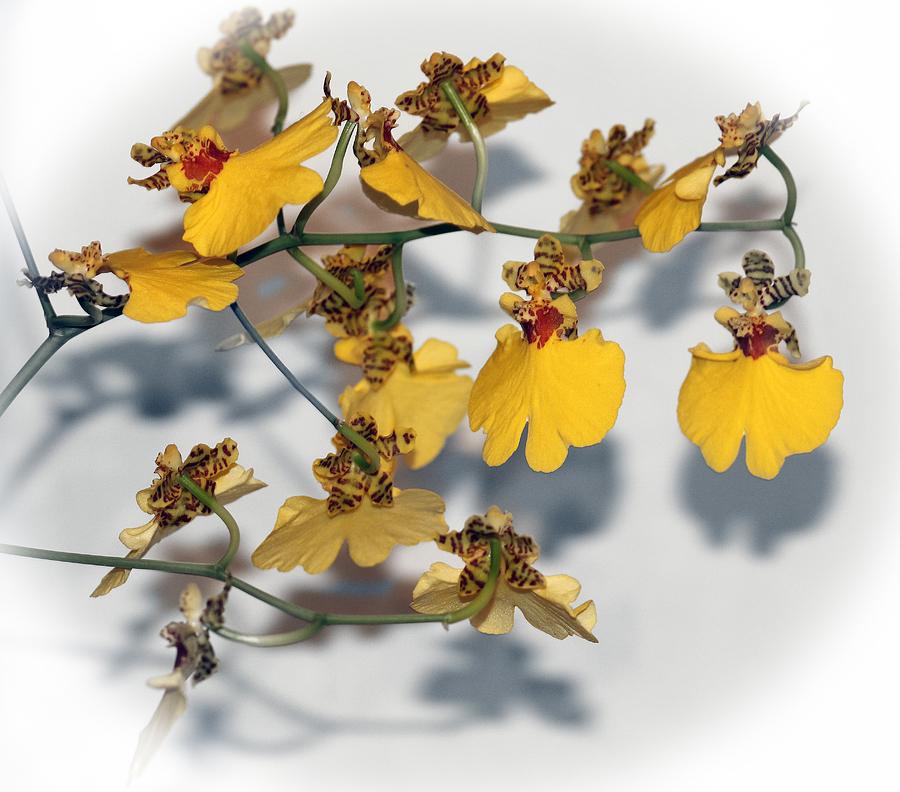 Therefore, before purchasing this orchid, it is necessary to take into account its “requirements” and, if possible, recreate the correct microclimate in the room. nine0127 Also, the flower has a pronounced dormant period, respectively, the conditions of detention change throughout the year.
Therefore, before purchasing this orchid, it is necessary to take into account its “requirements” and, if possible, recreate the correct microclimate in the room. nine0127 Also, the flower has a pronounced dormant period, respectively, the conditions of detention change throughout the year.
Table: optimal conditions for growing oncidium
| Factor | Recommendations |
| Location | POCTOCE SEGOUS, SEGOOUS SEGOUS, SEGOOUS SEGOME, ON SECHE. The plant does not tolerate stale air, so the room must be regularly ventilated. In summer, it is useful to take the pot out to the balcony, veranda, or garden. There, the required temperature difference is achieved naturally. nine0270 |
| Lighting | Bright but diffused light is required. From direct sunlight, the plant is shaded. Daylight hours are 10-12 hours all year round. In winter and autumn, the orchid is illuminated with special fitolamps (from ordinary leaves they acquire an unnatural purple hue). |
| Temperature | During the active vegetation period - 24-26ºС during the day and 18-20ºС at night. Such a difference during the day is a necessary condition for flowering. In winter, the temperature is lowered to 15-17ºС. nine0270 |
| Humidity | The optimum value is 50–70%. In extreme heat and in winter, oncidiums are sprayed so that drops do not fall on the flowers. Wet expanded clay is placed in the pallet. You can also place special devices in the room that humidify the air, or put a pot in the florarium. If the room temperature drops below 18ºC, additional humidification must be stopped. |
At the time when solar activity is maximum, oncidium should be shaded
Planting and transplanting procedure
Any orchids, including oncidium, do not tolerate transplanting very well, so they try not to disturb them unless absolutely necessary. The procedure is carried out if the flower has clearly outgrown its pot, the roots have begun to rot, the substrate has turned into dust. Based on the growth rate of oncidium, it is enough to transplant it once every 3-4 years.
Based on the growth rate of oncidium, it is enough to transplant it once every 3-4 years.
Preparation for transplanting into a new pot
Special substrate for orchids can be purchased at the store. This “soil” bears little resemblance to the soil in the usual sense of the word. nine0127 It consists of small pieces of pine bark, charcoal, peat chips and chopped sphagnum moss, taken in approximately equal proportions. Sometimes, to prevent the development of rot, coarse river sand, crushed chalk, crumbs from old red bricks (about 10% of the volume of the finished mixture) are added. If all the ingredients are available, the substrate can be mixed by itself, pre-treated with steam or otherwise sterilized.
Do not rush to transplant if the roots stick out from the top of the pot. For oncidium, the presence of aerial roots is normal. nine0003
Orchids need a very specific substrate that bears little resemblance to the soil that "suits" other houseplants
Unlike other orchids, the oncidium does not need a transparent pot. Its roots do not contain chlorophyll, therefore they do not participate in the process of photosynthesis and do not need light. The best choice is a wide and shallow plastic container with one or more drainage holes.
Its roots do not contain chlorophyll, therefore they do not participate in the process of photosynthesis and do not need light. The best choice is a wide and shallow plastic container with one or more drainage holes.
In the process of transplanting, it is imperative to cut off all rotten and dead roots
Step-by-step instructions
The transplant itself looks like this:
- Remove the orchid from the pot and clean the old substrate from the roots. To do this, you need to immerse the pot in a container of water for 2-3 hours.
- Carefully inspect the roots, cut off all dried, dead, rotten to healthy tissue. Treat the "wounds" with crushed activated carbon, chalk, colloidal sulfur, cinnamon. Let dry by leaving the plant outdoors for a few hours.
- Fill a third of the new pot with expanded clay, pebbles, or other drainage material. Above - a layer of substrate 2–3 cm thick.
- Place the orchid in the pot so that the oldest pseudobulb is located about 2 cm from its edge, and the young one “looks” towards the center.
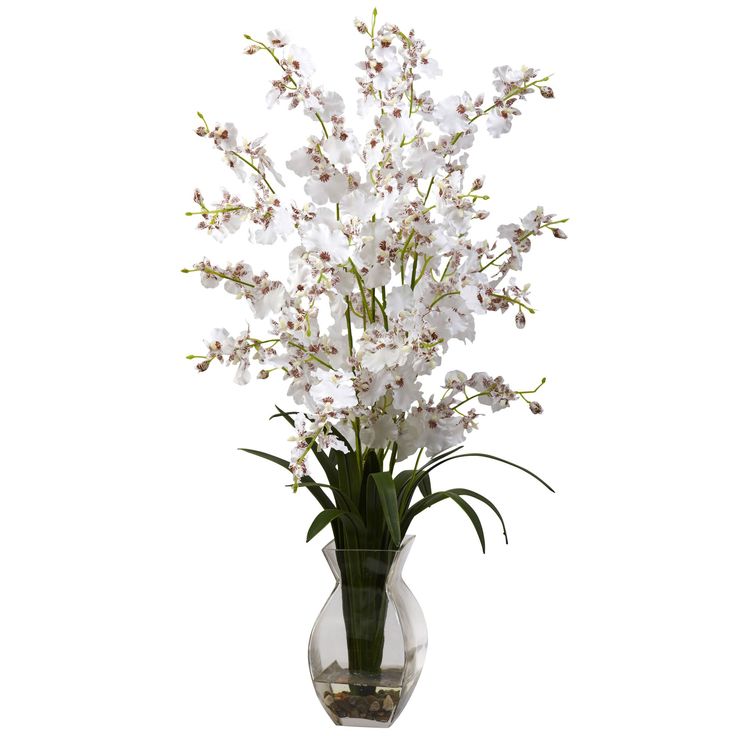 This is due to the fact that the oncidium grows in only one direction. This will give the flower enough room to grow.
This is due to the fact that the oncidium grows in only one direction. This will give the flower enough room to grow. - Add substrate. Keep the top third of the pseudobulbs above the surface.
- Cover protruding aerial roots with a thin layer of dry or fresh sphagnum moss, moistening it slightly. Then do not water the plant for 5-7 days. nine0014
Oncidium in a new pot is positioned so that the plant has enough space for development
Video: how to transplant an orchid
Oncidium bought in a store should not be transplanted immediately. Give the plant about a month to adapt to new conditions. When choosing a flower, pay attention to the following:
- Number of pseudobulbs. There must be at least three of them.
 Otherwise, we can conclude that the flowering of the orchid is stimulated artificially. Such plants are very weak, easily affected by diseases and pests. nine0014
Otherwise, we can conclude that the flowering of the orchid is stimulated artificially. Such plants are very weak, easily affected by diseases and pests. nine0014 - Uniform leaf color. There should be no light green and brown spots, yellowness.
- Aerial roots condition. If they are dark, slimy to the touch, there are traces of mold, refrain from buying.
- Substrate quality. It should not be either dry or flooded.
Important nuances of flower care
Orchids deservedly have a reputation for capricious and demanding plant care. Oncidiums are quite consistent with it.
Watering
Correct and timely watering is the key to good health and regular flowering of oncidium. In both waterlogged and dry soil, the plant will soon die.
An adult orchid in the period of active growth needs one watering every 7-10 days. In winter, the interval between them increases to 15–20 days. The substrate must dry at least 10 cm deep.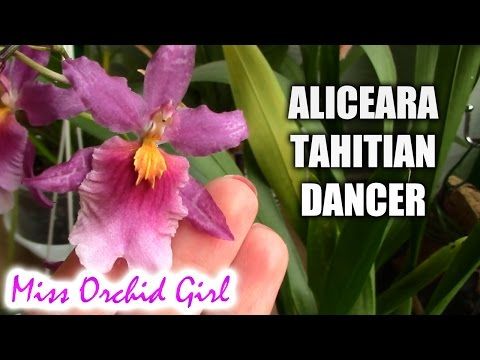 To test this, stick a wooden stick into it.
To test this, stick a wooden stick into it.
It is carried out by immersion, lowering the pot into a container of water heated to a temperature slightly above room temperature for 45–60 minutes. nine0128 Then you need to allow excess moisture to drain and dry the plant well.
It is best to water the oncidium, like other orchids, by immersion
As soon as a new pseudobulb appears, watering is stopped, otherwise you may not wait for flowering. After the formation of the peduncle (about a month later), the moistening of the substrate is resumed as usual. When the orchid fades, watering is gradually reduced, preparing it for a dormant period.
Only soft water is used, heated to a temperature slightly above room temperature. nine0128 If it is not possible to collect thawed or rain water, defend the water supply. Add a little citric acid or apple cider vinegar to neutralize the hardening compounds of calcium, chlorine and fluorine.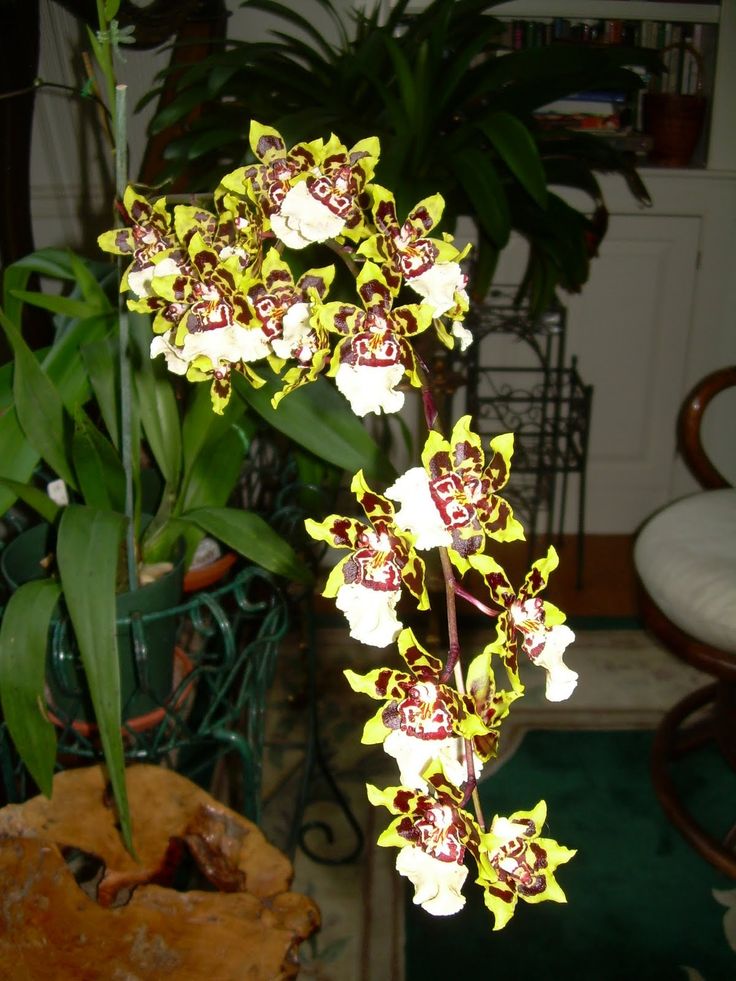 Water can also be boiled or passed through a filter.
Water can also be boiled or passed through a filter.
Fertilization
Oncidium needs top dressing only during the growth of new shoots. Fertilizers begin to be applied when the peduncle appears and stop as soon as the buds open. One procedure every 15-20 days is enough. nine0003
The peculiarity of the plant is its extreme sensitivity to substrate salinity. Therefore, even when using special products for orchids, the dosage of the drug is reduced by half or 10 times, depending on whether root dressing is carried out (the product is added to water for irrigation) or leaf spraying. It is recommended to alternate fertilizer application methods.
Orchids are fed only with fertilizers specially designed for them, other preparations will do more harm than good
Excess nutrients stimulate leaf development at the expense of flowering. Choose a fertilizer with a minimum nitrogen content.
Dormant period
Only varieties of oncidium have a pronounced dormant period after flowering, without pseudobulbs. For 2-3 months they need to be placed in a bright, cool (15-17ºС) place, increasing the intervals between waterings (it is better to replace them with spraying of leaves and aerial roots altogether) and stopping feeding.
For 2-3 months they need to be placed in a bright, cool (15-17ºС) place, increasing the intervals between waterings (it is better to replace them with spraying of leaves and aerial roots altogether) and stopping feeding.
Put the “resting” oncidium on the windowsill, moving it as close as possible to the glass. The plant is fenced off from a warm room with a screen or a screen. Working radiators are covered with a thick cloth.
Video: proper plant care
Flowering
Oncidium does not have a certain flowering period. Buds appear at any time of the year. If the care is completely satisfied with the plant, the phenomenon pleasing to the eye of the owner can be repeated in 4–5 months. nine0003
Regular flowering is a clear sign that the oncidium is satisfied with the departure
A huge disappointment for the orchidist is the appearance of a new vegetative shoot instead of the expected peduncle.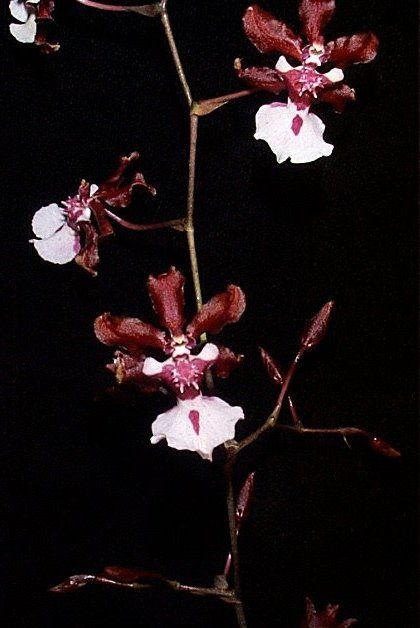 Most often, this means that the required conditions were not created for the oncidium during the dormant period. And if a plant has less than three pseudobulbs, it simply does not have enough strength to form a peduncle.
Most often, this means that the required conditions were not created for the oncidium during the dormant period. And if a plant has less than three pseudobulbs, it simply does not have enough strength to form a peduncle.
Other common reasons for lack of flowering are improper watering and untimely fertilization. Also, inexperienced flower growers often remove dry integumentary scales, injuring growth buds. nine0003
It is normal for the pseudobulbs to shrink and shrivel a bit during flowering. When it is completed, you need to cut the flower stalks as close to the surface of the substrate as possible.
Video: how to make oncidium bloom
Typical mistakes of a novice grower
It is clear that the plant is not satisfied with the care, the lack of flowering signals. But there are other alarming signs, noticing which the grower should immediately correct his actions. Therefore, in order to understand what exactly was done wrong, it is important to be able to recognize the “signals” given by the oncidium. nine0003
But there are other alarming signs, noticing which the grower should immediately correct his actions. Therefore, in order to understand what exactly was done wrong, it is important to be able to recognize the “signals” given by the oncidium. nine0003
Table: how oncidium reacts to mistakes in care
| How a flower looks like | What is the reason |
| Sunburn. | |
| Leaf tips dry, pseudobulbs wrinkled. | Room humidity too low. |
| “Wet” black or dark brown spots spread on leaves and pseudobulbs. nine0270 | Too frequent and/or excessive watering. The development of rot is accelerated by low room temperature and cold drafts. |
| Large irregularly shaped light spots appear on the leaves and petals. | Too much fertilizer in the soil. Or the wrong tool is selected. |
| Leaves are turning yellow. | Unsuitable substrate.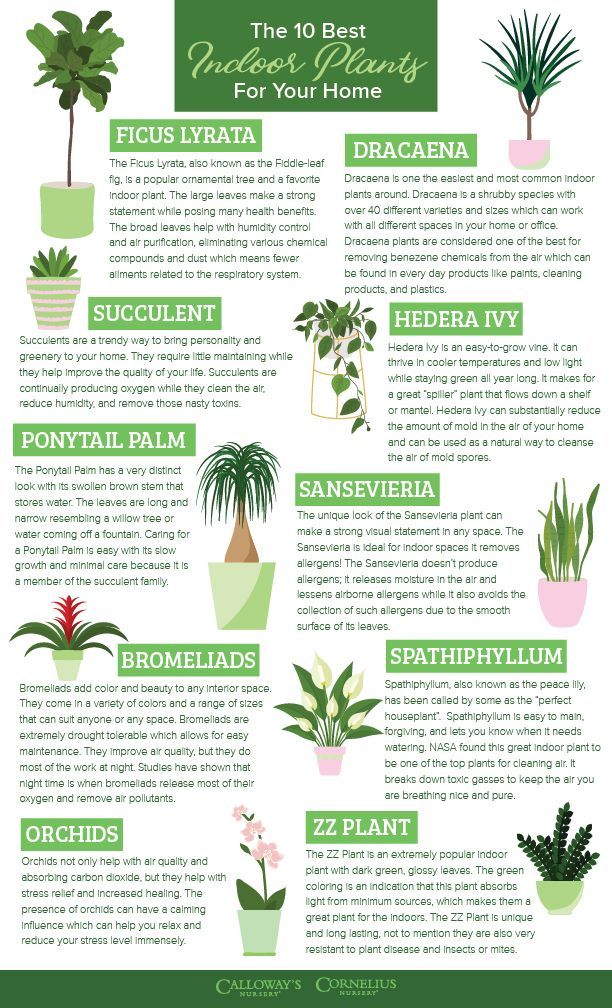 Or hard water is used for irrigation, causing it to become saline. Or hard water is used for irrigation, causing it to become saline. |
| Buds dry and fall off before opening. nine0270 | Lack of light. Or the plant needs to be transplanted - the soil is already too poor. |
Oncidium immediately signals that the grower's actions do not suit him; the task of the owner is to learn to decipher these signs
How to deal with diseases and pests
Oncidiums often suffer from rot caused by improper watering. "Love" orchids and various pests that feed on plant sap. The risk of infection can be significantly reduced by following simple preventive measures:
- quarantine all new plants for at least one month;
- inspect flowers at least once a week (preferably with a magnifying glass) and immediately isolate any specimens with suspicious symptoms;
- regularly ventilate the room;
- place indoor flowers and bouquets as far apart as possible;
- use only clean and disinfected pots, be sure to sterilize the substrate;
- follow the rules and recommendations for caring for the plant, especially in terms of watering and fertilizing; nine0270
If the disease has gone too far, it is no longer possible to save the orchid. 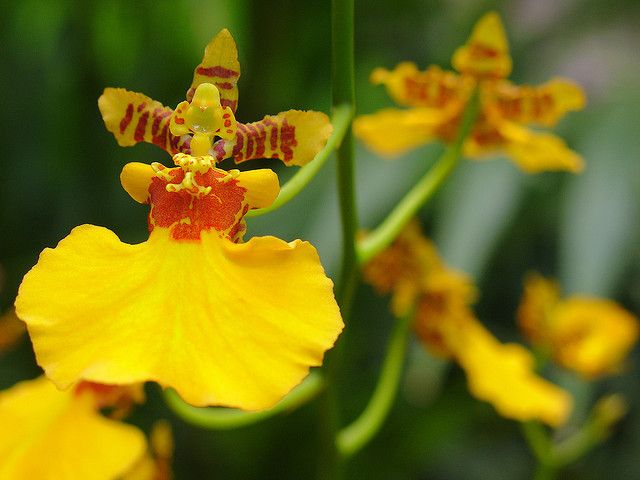 It remains only to throw it away. At an early stage:
It remains only to throw it away. At an early stage: - Remove the plant from the pot, cut off all rotted areas to healthy tissue. Treat the wounds.
- Transplant the plant by changing the substrate and sterilizing the pot. Add Alirin-B, Glyokladin or Baikal-EM to the soil.
- Within six months, once a month, replace the water for irrigation with a 0.2% solution of Fundazol or Topsin.
Bacterial rot Fast growing light brown "watery" spots on young leaves and new pseudobulbs. - Cut off all infected tissues, treat "wounds".
- Spray the plant and shed the substrate with a 1% solution of any fungicide (Bordeaux mixture, HOM, Oxych) 2-3 times at 15-20 day intervals.
- Within six months, every 2-3 weeks, treat the flower with any biostimulant - Epin, Zircon, potassium humate. nine0014
Mealybug Small white lumps resembling cotton wool in the axils of the leaves and a thin layer of the same color on their underside. 
- Apply a lather of laundry or green potash soap to the plant, wash off in a warm shower after an hour.
- Spray the flower and substrate abundantly with a solution of Aktara, Mospilan, Aktellik.
- Put a plastic bag over the pot, seal tightly, leave for 2-3 days.
- Repeat treatment 3-4 times at 7-10 day intervals. nine0014
Scale Brown or grayish growths, almost flat at first, then "swelling". The tissues around them turn red or turn yellow. - Use a cotton swab to apply alcohol, vinegar, kerosene, turpentine, machine oil to the shells of pests. After 2-3 hours, remove the shield.
- Give the plant a warm shower, treat with Phosbecid, Metaphos, Fozalon.
- Repeat the procedure 2-3 times with an interval of 5-7 days.
Thrips Yellow and silver thin lines (like scratches) and small black dots on the underside of the sheet. - Wipe the orchid with alcohol or any alcohol tincture, wash it in the shower after 10-15 minutes.

- Treat the flower with Actellik, Tanrek or Fitoverm.
- Repeat after 10-12 days.
Spider mite A thin cobweb that wraps around leaves and buds, pale yellow spots on the underside of the leaf. nine0270 - Treat the plant with a soap and alcohol solution, wash it off after 25-30 minutes.
- Thoroughly water and spray the flower, place in a bag for 2-3 days.
- If there is no effect, treat with Neoron, Apollo, Vermitek 2-3 times, changing preparations.
Whitefly Whitish moth-like butterflies that rise every time the flower is touched. - Hang fly tape or homemade traps next to the orchid. nine0014
- Vacuum the plant early in the morning to remove visible pests.
- Apply lather to the leaves, wash off in the shower after one hour.
- Spill the substrate with a solution of Biotlin, Inta-Vir, Mospilan (2-3 times with an interval of 7-10 days).

Aphids Small yellow-green or black-brown insects that clung to young leaves, pseudobulbs, buds. - Spray the plant 3-4 times daily with infusions of any strong-smelling herbs, onions, garlic, hot peppers, tobacco chips, citrus peel. nine0014
- If there is no effect, wash the flower in the shower, treat with Aktara, Biotlin, Iskra-Bio.
- Repeat the procedure 3-4 times with an interval of 5-7 days.
Photo gallery: with what diseases and pests you will have to encounter when growing oncidium
- Racial prevention should be paid to special attention,
- 193 The most effective in the fight against bacterial rot are copper-containing preparations - fungicides
- Mealybug does not like high humidity - spray the plant more often for prevention
- with the use of insecticides
- An orchid infected with thrips practically stops growing, its leaves are deformed
- Wide insecticides against the spider mite will not help - special preparations (acaricides)
- Belkalka - therefore a good effect is given a good effect is the tape for fishing for mud
- Aphid is a “universal” pest of indoor plants, it will not pass by succulent orchid leaves either
- Remove the oncidium from the pot and remove the substrate from the roots.
- Using a sharp, disinfected knife, cut the rhizome so that at least three pseudobulbs remain on each part.
- Treat "wounds" by sprinkling them with crushed chalk, activated charcoal, cinnamon.
- Plant immediately in a suitable dry substrate for orchids, provide the usual conditions. For the first 7-12 days, do not water to allow the cuts to tighten. It is enough to spray the leaves.
- Author: Julia Golova
- Oncidium is what kind of orchid
- What is the “basic” color of these flowers
- Principles of home flower care0014
- Transplanting this orchid
Reproduction of oncidium at home
At home, oncidium is most often propagated by dividing the bush.
 Planting individual pseudobulbs is rarely practiced - they would rather rot than take root. The selected plant must have at least six tuberidia and be of sufficient age (minimum 3-4 years). The best time for the procedure is the end of winter or the beginning of spring.
Planting individual pseudobulbs is rarely practiced - they would rather rot than take root. The selected plant must have at least six tuberidia and be of sufficient age (minimum 3-4 years). The best time for the procedure is the end of winter or the beginning of spring. Propagate the oncidium at home by dividing the bush
The knife used to divide the bush must be sharp and disinfected
A grower who wants to grow an oncidium must be prepared for the fact that this orchid will require him to pay regular attention to it and strictly follow the rules of care.
 However, the time and effort spent is more than paid off by the abundant and long flowering of the “dancing chrysalis”. Its "cascading" inflorescences will not go unnoticed even in the most extensive collection of exotic indoor plants.
However, the time and effort spent is more than paid off by the abundant and long flowering of the “dancing chrysalis”. Its "cascading" inflorescences will not go unnoticed even in the most extensive collection of exotic indoor plants. 27 years old, higher legal education, broad outlook and interest in a variety of topics. nine0003
Rate the article:
(0 votes, average: 0 out of 5)
Share with your friends!
home care, photo
One day my boyfriend and I got together to visit his distant relative for her birthday. This lady in the family was famous for her great claim to originality, and we broke our heads about what to give - such a lady would consider ordinary roses vulgarity, and daisies are too modest ... , "dancing girl". nine0003
True, the day before the holiday it turned out that it would not happen - a relative's favorite cat was in the hospital, and she was not in the mood for fun .
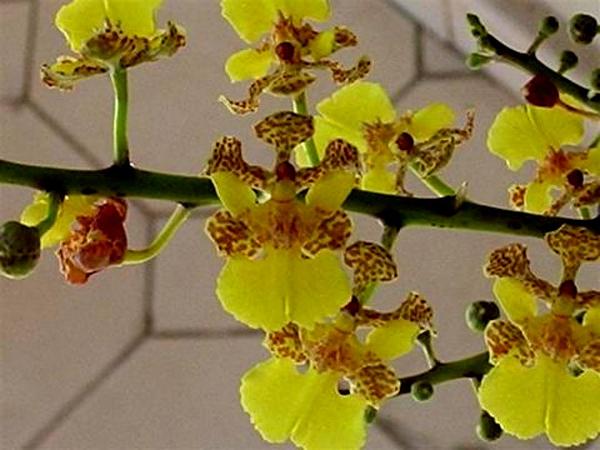 .. The yellow oncidium remained growing in our apartment. These walls did not know such decoration yet!
.. The yellow oncidium remained growing in our apartment. These walls did not know such decoration yet! Contents of the article
Oncidium is what kind of orchid
Came to us from Central and South America, this "epiphyte" won the hearts of flower lovers with its unpretentiousness.
And, although oncidium flowers are small and rarely bloom (for a month, once every 8-12 months a year), many sincerely love this particular genus.
The orchid got its second name ("dancing girl") thanks to the lower lip of the flower - expressive, really similar to a girl's skirt. When a breeze hits the flower, this “skirt” gently sways, as if really from a dance. nine0003
In addition to the original flower, the plant also has pseudobulbs - a rounded transition from the stem to the rhizome.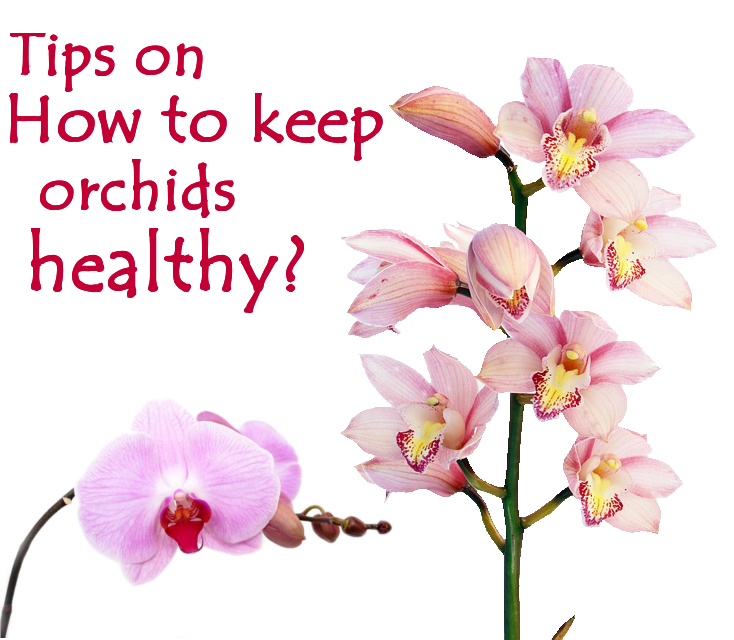 This photo shows exactly how they look (however, the bulb is shown "dried" - this is a sure sign that the orchid is thirsty).
This photo shows exactly how they look (however, the bulb is shown "dried" - this is a sure sign that the orchid is thirsty).
Interesting! The more pseudobulbs a plant has, the more often it blooms. Modern hybrids are also considered long-flowering - they can delight with flowers both 2 and 3 times a year.
What is the "basic" color of these colors
Unlike most types of orchids, which are good only in the wild and greenhouses, oncidiums take root well in our homes. Yes, now there are many hybrid varieties, but natural species are quite amenable to "training".
These orchids are:
- Yellow. Such flowers can please Yellow Oncidium, Sweet Sugar, Twinkle.
- Yellow with red dots. With such flowers, the Sinuous or Moth Oncidium pleases.
- Brown-red. This is a typical coloration of the Tiger variety. In addition to coloring, it is noticeable by its growth - the peduncle grows up to 1 meter (compared to the 30-centimeter Sweet Sugar - just a giant).
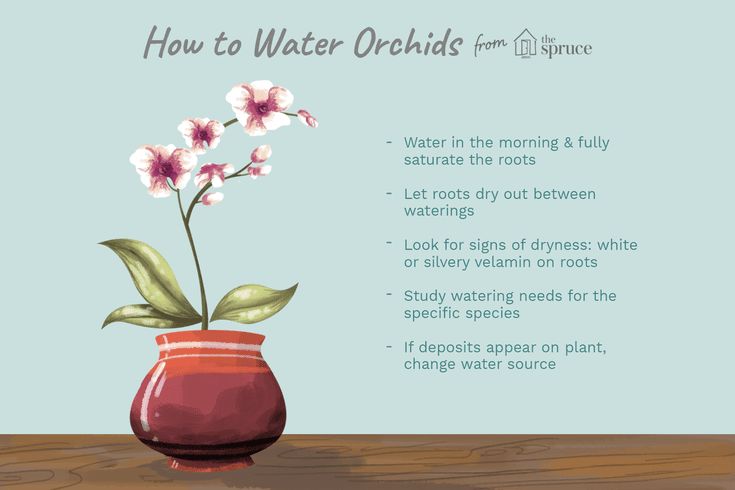 nine0014
nine0014 - Brown-pink. Orchid Lanz coloring.
- Pink and white. These are also the colors of the Twinkle variety.
Principles of home flower care
- Lighting. Oncidium will like the location on the western or eastern windowsill - that is, so that there is a lot of light, but it does not fall directly on the leaves. Sometimes this plant begins to bloom in winter. In this case, even the southern window sill is not enough for him, because the daylight hours are so short in winter! I'll have to buy a phytolamp. nine0014
- Room temperature. In summer, the flower is good both at 20 and at 30 degrees. In winter, he feels quite comfortable at 18 degrees, but a more significant decrease (but not lower than 7 degrees) will not harm him.
- Watering. It is interesting here: during the growth of leaves and stems, as well as when a flower arrow appears, water should not be saved. It is better to water the flower by immersion in a basin with “drinking” (that is, settled) water.
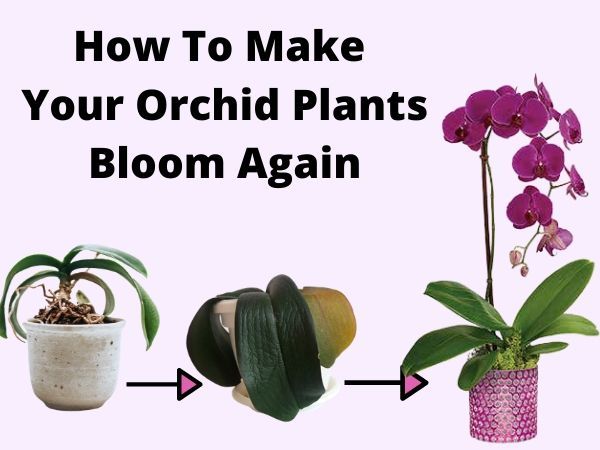 And when the pseudobulb is growing or when flowering ends, you need to water the flower very carefully. nine0014
And when the pseudobulb is growing or when flowering ends, you need to water the flower very carefully. nine0014 - Spraying. Not required. They can be carried out only in extreme heat, or in winter, with the "terror" of radiators. If the temperature in the room is below 18 degrees, it's time to hide the spray gun.
- Ventilation. Unlike spraying, a flower needs clean air at any time of the year. But make sure that the orchid does not stand in a draft, and also that it does not freeze (which species is especially sensitive to low air temperatures, read below).
- Nutrition. Top dressing, as well as active watering, is carried out with the growth of the orchid or at the beginning of flowering (until the arrow grows and the flowers have not blossomed - as soon as they bloom, stop feeding). Make a solution of complex fertilizer for orchids weak. It is better to make it after watering with a watering can, but it can also be sprayed. nine0014
- Special growing conditions.
 Oncidium requires winter dormancy. But not all varieties. Yes, hybrids that have bulbs can "winter" in their usual environment. If the plant does not have pseudobulbs, after the end of shoot growth, it needs to rest. Do not feed, rarely water the flower, and if possible, move the pot to a colder room.
Oncidium requires winter dormancy. But not all varieties. Yes, hybrids that have bulbs can "winter" in their usual environment. If the plant does not have pseudobulbs, after the end of shoot growth, it needs to rest. Do not feed, rarely water the flower, and if possible, move the pot to a colder room.
Temperature preferences of oncidium orchids vary by species
- Cold-loving. These are Sinuous and Warty oncidiums. Their homeland is cool mountain forests, so plants prefer a maximum of 22 degrees in summer, and about 8 degrees in winter.
- "Medium". Tiger and Beautiful oncidium are good in winter at 13-15 degrees, and in summer at 20-25.
- Thermophilic. Oncidium Lanza and Butterfly will not bloom if the room is colder than 15 degrees in winter and below 25 in summer.
In most of our stores you will only find Dutch oncidium hybrids. They are considered the most unpretentious: they bloom both at 26 and at 14 degrees. nine0003
nine0003
Transplanting this orchid
Like other orchids (say Cattleya), oncidium does not like to be disturbed by transplanting.
- On average, the plant is transplanted every 3 years.
- There may be several reasons: compacted and/or saline substrate, roots that do not fit in the pot, suspicion of rot inside the pot.
- The procedure is carried out in the spring.
- The pot can be taken wide, but not deep, from an opaque material. nine0014
- Clean pine bark can serve as the ground. However, it can be flavored with sand (coarse, river), chalk, charcoal.
- Always add drainage to the bottom of the pot.
- After planting a flower, the substrate can be shed with a solution of "Fundazol" ("vaccination" against diseases, made from 1 liter of water and 2 g of this medicine).
When transplanting from rootlets, all old soil must be stripped. If it does not go away, the plant can be soaked in water (only the roots), and then gently rinsed.